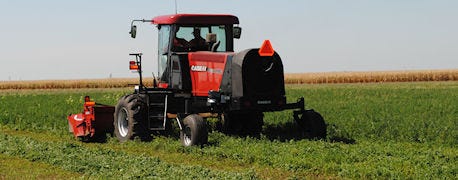May 8, 2013

Wet soils and other field work are preventing many folks from planting alfalfa at the optimum time. Bruce Anderson, University of Nebraska-Lincoln Extension forage specialist, offers the following short cuts may help you catch up and balance your spring work.
Conventional alfalfa plantings involve several tillage operations to prepare a firm seedbed, followed by drilling the alfalfa seed.
"Some folks, though, save time by using a floater or air seeder rather than a drill," Anderson says. "This requires less tillage since it's best to leave the field slightly rougher than normal and the floater should be able to plant faster."

Try Several Shortcuts For Planting Alfalfa
However, he has one caution: Make sure the custom applicator is experienced at spreading the seed evenly. After broadcasting the seed, cover it with a little soil. Two quick passes with a flat drag harrow or a roller seem to work best.
"No-till or low-till seedings also can save much time," Anderson adds. "It works best in bean stubble, but small grain and even corn and sorghum stubble can be used. If residue is heavy, first shred or chop stalks so they are spread across the ground uniformly. After they dry the drill will be able to cut through them easier."
Also, if the field has much ridging from previous crop rows, disk lightly to level the ground so future trips across the field will not be so rough.
If weeds are present, spray a burn-down herbicide like glyphosate or Gramoxone before planting if light disking didn't get them. Then seed no-till, and be ready to use a postemergence herbicide like Poast Plus, Select, Buctril, Raptor, or Pursuit for early weeds, according to Anderson.
"For best results you still must seed alfalfa by May 15 on dryland or May 31 with irrigation for best results," he adds.
Set The Schedule For Hay Quality. Deciding when to make the first cutting of hay sets the stage for the rest of the year. Download our FREE report 10 Hay Farming Basics: Producing A Quality Hay Product today.
You May Also Like




